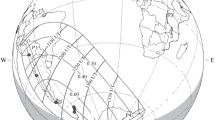Abstract
The total solar eclipse on July 2, 2019, has been studied by using data of the La Serena ground magnetic station in Chile located in the path of the totality (at geographic coordinates: 29.827° S, 71.261° W). The event reached 100% darkness and occurred from 1522:34 hr to 1746:36 hr LT. We monitored the X, Y, Z‑components of the geomagnetic field with a fluxgate magnetometer to investigate their variation caused by the passing of the Moon in front of the Sun. Our results show positive growth up to ∼12 nT for all components in the same time window during the eclipse and in total synchrony with its phases. Having to discard any effect on the observations such as magnetic and solar activities, seasonal and geographical conditions, and instrumental effects, we report a total increase of the geomagnetic field during this phenomenon.




Similar content being viewed by others
REFERENCES
Association of Universities for Research in Astronomy, AURA-Chilean Eclipse 2019, Washington, DC, 2019. https://www.eclipsesolar2019.cl.
Ateş, A., Büyüksaraç, A., and Bektaş, Ö., Geophysical variations during the total solar eclipse in 2006 in Turkey, Turk. J. Earth Sci., 2011, vol. 20, no. 3, pp. 337–342. https://doi.org/10.3906/yer-0906-14
Ateş, A., Ekinci, Y.L., Büyüksaraç, A., Aydemir, A., and Demirci, A., Statistical analysis of geomagnetic field variations during the partial solar eclipse on 2011 January 4 in Turkey, Res. Astron. Astrophys., 2015, vol. 15, no.5, pp. 742–752. https://doi.org/10.1088/16744527/15/5/011
Bravo, M., Martínez-Ledesma, M., Foppiano, A., Urra, B., Ovalle, E., Villalobos, C., Souza, J., Carrasco, E., Muñoz, P., Tamblay, L., Vega-Jorquera, P., Marín, J., Pacheco, R., Rojo, E., Leiva, R., and Stepanova, M., First report of an eclipse from Chilean ionosonde observations: Comparison with total electron content estimations and the modeled maximum electron concentration and its height, J. Geophys. Res.: Space Phys., 2020, vol. 125, e2020JA027923. https://doi.org/10.1029/2020JA027923
Kim, J.-H. and Chang, H.-Y., Statistical analysis of geomagnetic field variations during solar eclipses, Adv. Space Res., 2018a, vol. 61, no. 8, pp. 2040–2049. https://doi.org/10.1016/j.asr.2018.01.022
Kim, J.-H. and Chang, H.-Y., Geomagnetic field variations observed by INTERMAGNET during 4 total solar eclipses, J. Atmos. Sol.-Terr. Phys., 2018b, vol. 172, pp.107–116. https://doi.org/10.1016/j.jastp.2018.03.023
Korte, M., Lühr, H., Förster, M., Haak, V., and Bencze, P., Did the solar eclipse of August 11, 1999, show a geomagnetic effect?, J. Geophys. Res.: Space Phys., 2001, vol. 106, no. 9, pp. 18563–18575. https://doi.org/10.1029/2001JA900006
Ladynin, A.V., Semakov, N.N., and Khomutov, S.Yu., Changes in the daily geomagnetic variation during the total solar eclipse of 1 August 2008, Russ. Geol. Geophys., 2011, vol. 52, no. 3, pp. 343–352. https://doi.org/10.1016/j.rgg.2011.002.007
Malin, S.R.C., Özcan, O., Tank, S.B., Tuncer, M.K., and Yazıcı-Çakın, O., Geomagnetic signature of the 1999 August 11 total eclipse, Geophys. J. Int., 2000, vol. 140, no. 3, pp. F13–F16. https://doi.org/10.1046/j.1365-246X.2000.00061.x
Momani, M.A., Al Smadi, T.A., Al Taweel, F.M., and Ghaidan, K.A., Magnetic field disturbances during the 2003 total solar eclipse over Antarctica as observed by magnetometers, Eur. J. Technol. Adv. Eng. Res., 2011, vol. 2, no. 2, pp. 69–75.
Obrecht, A., El eclipse de sol del 16 de abril: su observación en Chile, An. Univ. Chile, 1893, vol. 84, pp. 260–264. https://doi.org/10.5354/0717-8883.2012.20642
Onovughe, E.V., Geomagnetic diurnal variation during the total solar eclipse of 29 March 2006, Int. J. Astron., 2013, vol. 2, no. 4, pp. 51–55. https://doi.org/10.5923/j.astronomy.20130204.01
Özcan, O. and Aydoğdu, M., Possible effects of the total solar eclipse of August 11, 1999 on the geomagnetic field variations over Elazig, Turkey, J. Atmos. Sol.-Terr. Phys., 2004, vol. 66, no. 11, pp. 997–1000. https://doi.org/10.1016/j.jastp.2004.03.009
Ruhimat, M., Winarko, A., Nuraeni, F., Bangkit, H., Andi Aris, M., Suwardi, and Sulimin, Effect of March 9, 2016 total solar eclipse on geomagnetic field variation, J. Phys. Conf. Ser., 2016, vol. 771, pp. 012036(1)–012036(4). https://doi.org/10.1088/1742-6596/771/1/012036
Stankov, S.M., Bergeot, N., Berghmans, D., Bolsée, D., Bruyninx, C., Chevalier, J.-M., Clette, F., De Backer, H., De Keyser, J., D’Huys, E., Dominique, M., Lemaire, J.F., Magdalenić, J., Marqué, C., Pereira, N., et al., Multi-instrument observations of the solar eclipse on 20 March 2015 and its effects on the ionosphere over Belgium and Europe, J. Space Weather Space Clim., 2017, vol. 7, pp. A19(1)–A19(23). https://doi.org/10.1051/swsc/2017017
Střeštík, J., The response of the 11 August 1999 total solar eclipse in the geomagnetic field, Earth Moon Planets, 2001, vol. 85–86, pp. 561–566. https://doi.org/10.1023/A:1017047627850
Yamashita, S. and Iyemori, T., Seasonal and local time dependences of the interhemispheric field-aligned currents deduced from the Ørsted satellite and the ground geomagnetic observations, J. Geophys. Res.: Space Phys., 2002, vol. 107, no. 1, pp. 1372(1)–1372(10). https://doi.org/10.1029/2002JA009414
ACKNOWLEDGMENTS
The authors thank the support of the Direction of Research and Development of the University of La Serena (DIDULS) through projects PEQ16141, PR18141, and PR18145, and the University of La Serena’s Space and Earth Observatory by the instrumental support that enabled the preparation of this paper. Special thanks go to E. Yizengaw, E. Zesta, M.B. Moldwin and the rest of the AMBER and SAMBA team for the data (http://magnetometers.bc.edu/), and go to F. Espenak, NASA/GSFC Emeritus, by Fig. 1 (https://eclipse.gsfc.nasa.gov/). The Dst index data were obtained from the World Data Center for Geomagnetism of Kyoto (http://wdc.kugi.kyoto-u.ac.jp/).
Author information
Authors and Affiliations
Corresponding authors
Rights and permissions
About this article
Cite this article
Vega-Jorquera, P., Lazzús, J.A., Tamblay, L. et al. Geomagnetic Field Variations during the Total Solar Eclipse of 2 July 2019 in La Serena, Chile. Geomagn. Aeron. 61, 287–292 (2021). https://doi.org/10.1134/S0016793221020171
Received:
Revised:
Accepted:
Published:
Issue Date:
DOI: https://doi.org/10.1134/S0016793221020171




